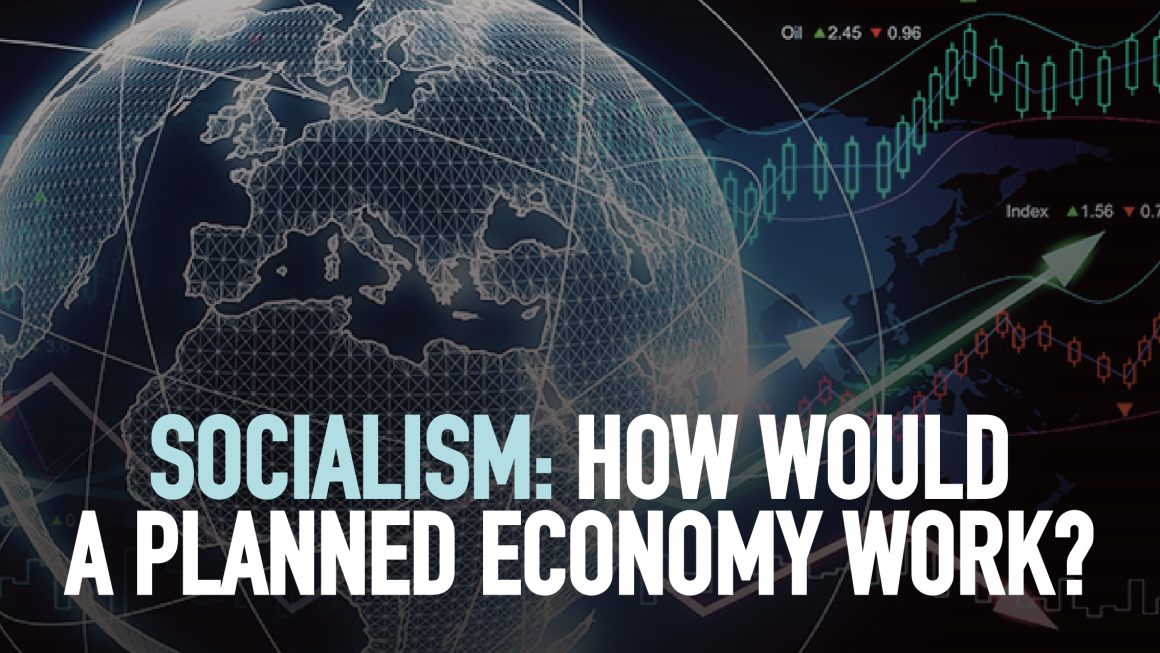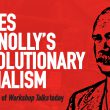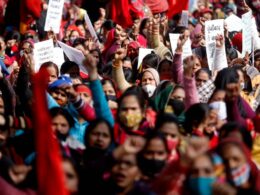By Peter Delsing, (ISA in Belgium)
This article is based on an introductory speech given to a commission on ‘Marxist economics — How would a planned economy work?’ at ISA’s Virtual Marxist University in July 2020.
The discussion about how a planned economy would work is a crucial one for the workers’ movement and the oppressed. Since the 1990s and the fall of the authoritarian Stalinist regimes the capitalists have stumbled from crisis to deeper crisis. But the capitalist class has one big advantage. Recent left wing currents around Bernie Sanders in the US, Corbyn in Britain and Mélenchon in France have defended important social demands, but unfortunately none of them have promoted the idea of democratic socialist planning of the economy. After the fall of the bureaucratically planned Stalinist economies, the ideas put forward by right wing economists about “lack of information” and “lack of innovation” in planned economies have been able to influence the political understanding of workers and youth. It’s time to clarify these issues and to rearm workers and youth with a programme for fundamental change.
Marx and Engels, the founders of scientific socialism, didn’t want to give a detailed blueprint of a post capitalist society. They didn’t want to put forward fantastical ideas without a basis in reality, as a reaction against the “utopian socialists”. The struggles of the working class would throw up the concrete political and economic institutions of the new society. Marx consciously limited himself to a general outline of socialism, for example in the famous Communist Manifesto of 1848. A complete break with the bosses’ profit system, with poverty and inequality, was needed. As a consequence socialists had to demand common ownership of the means of production — the factories, workplaces and technology. A socialist society needed to be based on the planning of production, workers discussing and setting goals for how and what to produce.
The heroic Paris Commune of 1871 gave Marx the opportunity to give an inspiring and lively picture of working class democracy. This involved free elections for the Commune, immediately recallable worker representatives, representatives not earning more than the average wage and the complete dismantling of the capitalist state. Marx called it the “finally discovered political form under which to work out the economic emancipation of the working class”. The Paris Commune took power in only one city. So it could only provide limited lessons with regard to the economic organization of socialism. Today though — after a decades-long relentless attack against the idea of economic planning and after the experience with Stalinist, top down planning — those struggling for a socialist world need to go a step further.
During the last few years, inspiring struggles have erupted against the exploitative, racist and sexist system. But most movements are still held back by knowing what they are against, but lacking an alternative to capitalism as an economic model. A more concrete picture needs to be given of how democratic planning could work in practice and how it would be different from Stalinist, dictatorial planning.
Cutting Away Enormous Capitalist Waste and Inefficiency
Imagine if the trillions of dollars of idle capital and hoarded wealth in the tax havens would be confiscated by workers’ governments, who could use it to eliminate hunger, build decent social housing and offer everyone a decent wage. Imagine if the billions invested in advertisement or unproductive financial services would be used to fund public services (education, healthcare, childcare,…) and hire more staff. Or if the duplication of products under capitalism and planned obsolescence — products breaking after a short period of time — would be done away with. This would enormously liberate resources for socially useful goods and services
What if the working class — through taxation of nationalized companies in a planned economy — would control the surplus in society? An enormous amount of money wouldn’t be wasted anymore on rich shareholders and capitalists who refuse to invest because of a generalized lack of purchasing power. Under socialist planning, the market for luxury products, which accounts for around 5% of GDP in developed countries, could be dismantled and the resources reoriented to socially useful production. And what do right wing economists think is “efficient” about growing capitalist mass unemployment? Under a democratic socialist plan these workers could contribute and find well paid jobs in public services, new ecological industries or mass infrastructure projects.
The health crisis around Covid-19, disastrous climate change, the effects of the new economic crisis, etc, are making the need for democratic planning much clearer to a broader layer in society. Capitalist governments made the corona crisis much worse by not wanting to damage the market. They should have immediately taken control of production lines to make masks, ventilators, etc. Leading health scientists, already years ago, have remarked that viruses with their highs and lows of infection are not a stable “business model” for the pharmaceutical industry. For profit driven capitalism, ecological destruction isn’t an “incentive” to start producing in radically different ways.
But the challenge for Marxists and socialists goes further. We need to show that planning could work, in a society which produces millions of products, with thousands of companies, though a concentration and centralization of capital in big multinationals, which plan internally, has reduced the number of companies which dominate the economy. Multinational companies now account for almost one third of global GDP and a quarter of total employment.
The aftermath of the “economic calculation” debate
Since the 1930s a debate has raged between capitalist economists and defenders of economic planning. The answer given by left-wing figures and activists to right wing objections against planning in principle has taken different forms. There have been arguments for centralized and completely decentralized forms of so called “market socialism”. On the other hand, some have tried to come up with schemes that jump immediately into a world without money and markets, directly producing for human needs based on modern technology and workers’ councils.
Both approaches have serious limitations from a Marxist point of view. The first one doesn’t take into account that in a situation of abundance, goods or services could start to be freely distributed, without the need for money. The second one underestimates how directly producing for human needs would require a transitional period of growth and coordination of the productive forces on a world scale. The preconditions for such an approach would not immediately exist. Also, establishing human need with modern technology before production takes place will, in many cases, not be a very efficient way of “planning”, for example for perishable consumer goods. Other forms of “real time planning” exist which can solve this problem — more about this later.
As a reaction against overly centralized, bureaucratic planning by Stalinist regimes some argue only for “self-management” by worker-owned enterprises. A lot of anarchist thinkers stand in this tradition. There’s also the influential American Marxist economist, Richard Wolff, who makes interesting videos about current topics and is often a first introduction to Marxist ideas for young people on the internet. Wolff wrote the book Democracy in the workplace, in which he defends the idea of “workers’ self-directed enterprises”, but he also wants to keep the market. This self-management by workers’ councils decides on its own how much power and means are given to higher political bodies.
The problem with this self-management in a market environment is that worker-owned enterprises would be forced to compete against each other. They would compete for market share and profits, be forced to crush each other and soon this “market socialism” would tend to imitate market capitalism. Moreover, this system was already tried in the former Yugoslavia under Tito after the Second World War. It abolished the solidarity among the working class, and led to competition among self-managed companies and between richer and poorer regions. It also led to mass unemployment.
Of course the former Yugoslavia remained a variant of a one-party state and of Stalinism. Self-management was guided by unelected, non-recallable party bureaucrats who manipulated the opinion of the workers. There was no free and democratic organization of the working class. But even if that would have been the case, the result under market conditions and “market socialism” would have tended to be the same. In Yugoslavia, market competition led to a return to hierarchies and leadership by managers in the name of efficiency and the maximisation of profit.
Also the state apparatus controlled by the richest 1% won’t just stand by and do nothing while more and more companies are taken under workers’ ownership from below. The capitalist state needs to be confronted by a mass movement of the working class with the aim of replacing it with a democratic but politically centralized workers’ state. Defenders of local self-management also underestimate the international division of labour and the need for international revolution and worldwide cooperation in a democratically planned economy.
Marx: the two economic stages of socialism
Marx thought that, economically, socialism would have two different stages of development. During the first stage, as long as general abundance wasn’t yet reached, certain elements of the capitalist approach to distribution would survive in a modified form. People would still be paid according to effort: the number of hours they worked. Though of course everyone would have access to a series of free or almost free services: the indirect or social wage. As one of its first measures, a workers’ government would shorten the working week to allow for economic and political decision making by the working class. But also to achieve a better balance between work and family, and free time. Resolving mass unemployment through democratic planning will help to lay the basis for a reduction of the working week through the redistribution of work without loss of pay. The means for this would be amply available once the dominant sectors of the economy are taken under public ownership and big companies were unable to ship enormous wealth to the tax havens.
Marxists called this first stage of socialism where elements of the market, money, payment according to hours worked, etc, still existed the “transitional economy”. Leon Trotsky, leader of the Russian revolution and opponent of Stalinism, stated about this stage: “Only through the inter-reaction of these three elements, state planning, the market and Soviet democracy, can the correct direction of the economy of the transitional epoch be attained”.
During a second stage, with the further expansion of the productive forces, once abundance is reached for certain products the number of freely distributed goods and services could grow. Money could become secondary or disappear, as people grew accustomed to a world without shortages. Marx summed this up in his Critique of the Gotha Programme as: “From each according to his ability, to each according to his needs.” This second stage would of course need to have a radical ecological transition during the first period as its foundation. There would need to be continual monitoring of the ecological footprint of the developing, green productive forces. Unlike short term, profit-driven capitalism, workers’ democracies would constantly have a material and social interest in making sure that our natural environment is not disrupted or harmed by economic progress.
Forms of planning: one approach does not fit all production
If both overly centralized, bureaucratic planning and isolated self-management need to be rejected, what is the way forward? To answer that question we can first look at which forms of planning already exist under capitalism that might be used — with the element of authoritarian planning removed — under socialism. We can also look at a form of planning which has been considered as particularly apt for socialist planning: input-output analysis.
The American giant Walmart is an awful union-busting, low wage company. It is the biggest company worldwide by revenue and had 2.2 million employees in 2019. If it was a country, it was calculated a few years ago that it would be the 38th biggest country in the world, based on its revenue. Walmart is also known as a pioneer of supply chain planning. Its methods have been copied by numerous other capitalist companies. You could say that it operates internally as a kind of planned economy — but based on authoritarian planning of course — for its 11,000 stores in more than 20 countries.
Walmart has made its operational efficiency better by the high tech, immediate sharing of information along its supply chains. Its suppliers organize its stock replenishment: it doesn’t do this itself. Walmart just shares the information from the cash register in real time with its suppliers and their suppliers along the supply chain. It offers its suppliers low price but high volume trade, based on a privileged relationship in which competition has been put on hold. Formally these suppliers are different companies which Walmart pays. But the number of market transactions has been reduced to gain efficiency through cooperation and planning. Walmart and its suppliers, while different companies, in practice behave as one company which is totally integrated in a planned way. Products aren’t pushed blindly into Walmart’s stock. They are pulled in real time by effective demand. It is a form of planning which is not based on a specific order for that specific product. Walmart’s planning model for consumer goods anticipates demand based on its real time evolution.
This is different from order-based planning, where production only starts when an order arrives. Cisco, the IT sector firm which produces routers and other technology for big companies, has this production model. Bigger and more expensive industrial or technological products can be served by order based planning, also under socialism.
Another form of planning based on physical output targets — and the input needed for their production — has been put forward as particularly apt for socialist planning: input-output analysis. This form of planning is also useful for growth sectors in a workers’ state. How many wind turbines and solar panels do we need to build as part of an emergency plan to save the environment? Which and how many inputs do we need for this and how much will this cost? Energy, types of raw materials, but also education and public transport are sectors where input-output analysis can be used. How many schools and teachers do we need based on decent class sizes? Which resources do we need for this?
Input-output planning can be used when the evolution of demand (or the numbers of users) is known over a longer period. For example, the number of users of a transport network or the evolution of the number of young people in different forms of education. It can also be used for sectors which workers’ states want to expand quickly as a matter of priority (ecological production as part of an emergency plan to save the environment, the socialization of domestic tasks, etc).
Based on democratic discussion, the share of the surplus going to education, healthcare, culture, public transport, sport, infrastructure, etc. can be decided. But also the budget needed for free childcare, public neighbourhood restaurants, public laundries, etc, to socialize the unpaid domestic tasks which are still often done predominantly by women. At all levels of the workers’ state — from the thousands of workplaces to the regional and national elected assemblies of the working class — a discussion would take place. This would be reflected in the workers’ press by opposing views and opinions about the main points of the programme and plan for these sectors.
Integrating levels and forms of planning — an answer to the “information problem”
Depending on the nature of the product or service in question, the workers’ state can opt for different forms of planning. To a certain extent, these could be inherited from the capitalist past but with the elements of authoritarian planning removed and replaced by democratic workers’ control and management. Councils of workers and young people in the workplaces, neigbourhoods, schools, and elected representatives on regional, sector and national level will manage the key sectors of the economy.
In principle, input-output analysis can be used today for a wide range of products and services. Computers can help a lot with this task. But in reality, it will be a democratic discussion which would decide about the type of planning and workers’ control and management to be implemented. Whether planning is more centralized or decentralized, workers’ democracy is always crucial for any level of planning. A centrally-designed plan would need to be discussed, modified and corrected by a living working class democracy of workers in the sector, users and suppliers.
In sectors where you have a lot of product variety — and where more output means a lot more input too — it might be decided to leave planning on the level of the nationalized company and its workers’ council. But then institutional measures would be needed to avoid competition between nationalized companies. Specifically, it makes sense to organize sector-based councils of workers, or regionally subdivided sectoral councils, to discuss changes in production in such a situation, to extend production of successful products to other nationalized companies, to reorganize employment or the length of the working week, etc, with workers’ interests being the central concern. Representatives of the national workers’ government should be present and part of this democratic debate. When decisions are made by voting in a company or group of companies, Marxists have put forward the idea of one third voting rights for the workers of the company itself, one third for the unions or elected representatives in the sector and one third for the workers’ government, to reflect all interests involved.
It is not just a question of using the bigger technological possibilities of today to make planning work. No computer algorithm with a large number of variables can be rendered efficient without the constant feedback of the workers and users. As Trotsky said in Revolution Betrayed: “Under a nationalized economy, quality demands a democracy of producers and consumers, freedom of criticism and initiative — conditions incompatible with a totalitarian regime of fear, lies and flattery.”
Once a planned economy is divided into several economic sectors and subcontractors are integrated with the main company, we would not be talking about thousands of companies to plan in each sector but more likely hundreds. These sectors could either be planned centrally, with sector representatives or through workers’ councils in the nationalized companies. In this last case, the process would need to be steered and managed by sector-level councils to maintain the solidarity of a successful socialist revolution and avoid the dead end of isolated “self-management”.
Putting things in this light changes the dimensions of the so-called “information problem”, which is presented in an obfuscating way by bourgeois ideology (and by some “market socialists” too). The idea of “millions of products produced by tens of thousands of companies” thrown up to suggest the impossibility of “centralized planning” creates a false image. We are not talking about one big centralized “superbrain” — or planning institution — coping with the information overload of millions of daily economic decisions. It must be noted that most products don’t interact with most other products. While there can be an overlap between certain sectors it is possible to divide the economy into different parts, which are relatively separate. When this is being done, we are talking about dozens of specialized planning institutions. These, moreover, can vary in relation to degrees of centralization. They can be highly centralized, as for a public transportation plan or steel production. Or they can be more decentralized, as for consumer goods.
It becomes clear that not one but dozens, and on the whole hundreds of thousands, of “planning centers” and brains, eyes and hands of workers are involved in a democratically planned economy. Organizing production in each sector on the appropriate level and with the best suited type of planning would make planning work. Modern technology will help a lot with this task. But democratic workers’ control and management is just as crucial for a healthy planned economy
Decisive weight for public ownership and the role of the workers’ government
Of course small shops with a handful of workers wouldn’t be nationalized. They would operate under the social regulations of the workers’ state. The decision about which companies of which size to nationalize would need to be taken based on an opening of the books of these companies, the nationalization of the banks, etc. But the nationalised part of the economy would need to represent the big majority of production. In Venezuela recently and in Nicaragua in the 1980’s only a minority of production was nationalized and not based on democratic councils of the masses. This gave a platform to reaction to sabotage the economy and prepare the political counter-revolution.
The national workers’ government would establish through discussion the relative share directed towards consumption and accumulation or investment. It could also determine how big of an “innovation fund” to hold in a nationalized company or in a sector. Part of workers’ wages would be the social or indirect wage used to pay pensions, healthcare, temporary unemployment pay for when people are allocated to another job, etc. Another role of the workers’ government would be to control pricing. Prices could be established on the central, sector or company level according to socialist accounting norms. If prices aren’t established centrally they could still be controlled quite easily by computer programmes and information technology.
A price might come to differ from the price in the plan or as prescribed by the established norm and this can be a signal to raise or lower production and reallocate resources from another planning level. However, a workers’ state does not function as a private profit making machine. Sometimes price controls can be deemed necessary — together with a lower surplus — because of social considerations while resources are being reallocated.
What if a workers’ state is boycotted by international capitalism?
Some might argue: what will happen in the case of a capitalist boycott of the revolution and a workers’ government aiming to build socialism? Especially with the growth in recent decades of worldwide supply chains? In Belgium, the new left PVDA/PTB — the Party of Labour — has argued in its theoretical journal that fundamental transformations in the economy and a possible break with the euro must await mass movements in several European countries at once, ready to break with neoliberal capitalism. They used the argument that Belgium is, in large part, dependent on electricity from French big business and that we must avoid being boycotted. ISA in Belgium has called for a critical vote for the PVDA/PTB during elections because it is the main force in parliament that fights against neoliberal cuts and ideology. We think, however, that this perspective for a break with neoliberal capitalism is schematic.
The threat of a boycott is of course real. But this approach underestimates how a real socialist revolution wouldn’t just be a leftwing majority in parliament nationalizing big sectors of the economy. It would be concrete workers’ power and democratic working class councils taking control of the workplaces. These councils in the workplaces would send elected representatives of workers and youth to regional and national assemblies of the workers, while these new structures mobilize to take power into their own hands and overthrow capitalism. The sight of such democratic workers’ power would immediately transform consciousness about the possibility and reality of socialism on a world scale. We are confident that the French working class with its combative traditions would be set ablaze by an attempt at any barbaric act by its own ruling class against a revolution in a neighbouring country.
Such a world-shaking event as a democratic socialist revolution would, with its government of the workers and the oppressed, launch a class appeal to break with capitalism in other countries. It would appeal for strikes against attempts to economically isolate and sabotage the revolution. It would start to link up economically with other revolutionary workers’ states to counteract any attempt by the capitalists to subvert and derail the socialist transformation of society.
Lessons from Stalinist planning
What went wrong with Stalinist, top down planning and what can we learn from it? The Russian revolution of 1917 had thrown up workers’ and soldiers councils which were a threat to the ruling class everywhere, as they offered a concrete example of a new socialist type of democracy. Unfortunately, however the Russian revolution remained isolated in a largely peasant country with a small industrial sector.
By the mid-1920s, a new despotic elite around Stalin started to take control of the planned economy. By this time, the workers’ councils had largely disappeared, undermined by war and economic ruin. The economic policies of the Stalinist bureaucracy were characterized by bureaucratic zigzags without much foresight as it balanced between different class forces, attempts at almost complete economic self-sufficiency and top down, dictatorial methods.
Plant managers received bonuses based on reaching physical targets, which encouraged the hoarding of resources and the underestimation of productive potential. It is revealing that in such an atmosphere, Stalin and the bureaucracy heavily relied on the state’s secret services to get a more accurate picture of the mood of the masses and the real economic situation. In a real workers’ democracy this would of course be absurd. Heavy industry and the war industry were the highest priority for Stalin and the new elite. But the opening of the archives has also shown that the Politburo often had to organize emergency meetings about the consumption of the masses. They feared a reaction when consumption would lag behind other economic indicators too much.
Despite the horrors of Stalinism, the planned economy allowed Russia to become a world superpower. GDP per head grew by a factor of 4.1 between 1928 and 1970, with much stronger growth than comparable colonial or ex-colonial countries. But by the 1970s, growth had slowed down. Misguided investment undermined productivity. Military expenditure reached 16% of GDP by the beginning of the 1980s. The heavy emphasis on the military tore away technical specialists from the civilian sector and the rate of new inventions in the non-military part of the economy dropped.
By the 1980s, misleading statistics and a lack of knowledge about the real economic situation were a major factor in preparing the turn of the top bureaucrats around Gorbachev towards capitalism. It’s important to emphasize that the elements which dragged down the Stalinist planned economies would not necessarily exist under a democratically planned economy. Bureaucratic overemphasis on heavy industry and the military as priorities, lack of real knowledge because the workers were not democratically organized and could not speak out, bureaucrats misrepresenting the situation in their own material interest, excessively centralized planning which reflected the bureaucratic need for tight control over the surplus, etc. Such bureaucratic elements would need to be cut away by a political revolution establishing workers’ democracy for a planned economy to develop in a healthy way.
“But where’s the incentive?”
Capitalist critics of socialism have told us that people will not get out of bed with free healthcare, a higher wage and more free time. We don’t agree of course. On the contrary, the thirst for political education and cultural self-development will grow exponentially. The working class will be as class conscious and vigilant as the capitalist class is today about anything which threatens its position and living standards. A revolutionary, conscious working class will be the best guarantee for productivity, quality, effectiveness, innovation and democracy.
Of course the biggest “incentive” under socialism will be that people will be secure in their job, have a much better quality of life, more free time, a developed welfare system and the ability to shape their own future and that of society through elected committees in the workplaces, schools, neighbourhoods, etc.
If incentives are used, they should be collective in a sector or nationally. Incentives at nationalized company level, if they have too much weight, will halt the spread of innovation and undermine solidarity. They would be a throwback compared to the spirit of a successful socialist revolution, which has just rejected all divisions among workers in the struggle for international socialism. Broader collective incentives would ensure that successful nationalized companies send their experts to other companies in the sector and — unlike under capitalism — all boats start to rise.
Economic activity in the end, with the advance of science and technology, will become a smaller part of life. At the same time it will be the indispensable basis for the all round development of the individual and society. The direct producers, i.e. the workers, will no longer be dominated by production — as under capitalism — as an alien force. While capitalism and its crisis deepens, millions will choose the path of struggle. Arming these struggles with the need for democratic planning of key sectors of the economy will be crucial if we want to organize workers and young people around a programme that can bring fundamental change.












